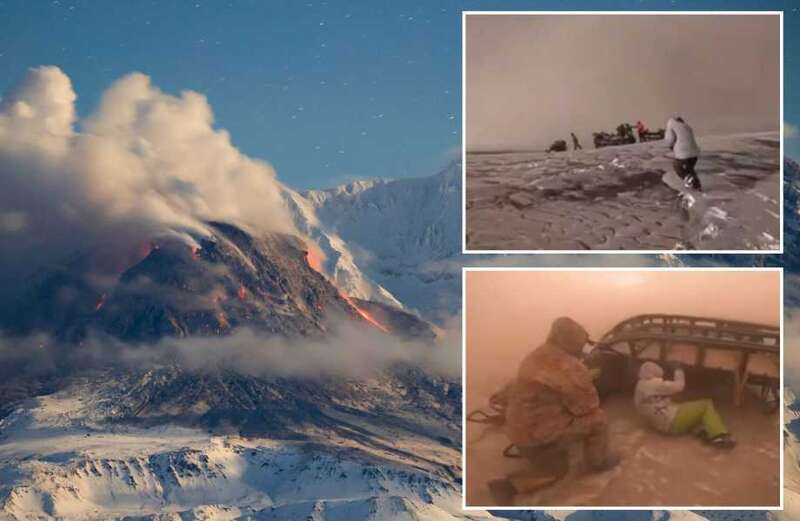A VOLCANIC eruption in Russia's far east sent snowmobiling scientists running for their lives and hiding as molten ash soared out from its bubbling crater.
Shiveluch - the largest and most active of Kamchatka's volcanoes - erupted early this morning and spewed thick ash over 41,700 square miles.




Shiveluch, which means "smoking mountain", regularly billows ash from its smouldering crater and has had 60 major eruptions in the past 10,000 years.
However, soon after midnight spitting lava flows oozed from the volcano that had been threatening to erupt for the past year.
Ash was violently thrown 12 miles into the air, which turned day into night as the dense cloud blocked out the sun.
 Putin accused of surrounding himself with same 'actors' at series of events
Putin accused of surrounding himself with same 'actors' at series of events
Several unfortunate volcanologists were far too close to the crater as the molten materials began spitting from its abyss.
The footage shows the scientists quickly running for cover under their snowmobiles as a dark storm of ash approaches them and they narrowly avoid falling rock.
As the cloud passed, it blanketed villages in the Kamchatka peninsula in 3.5 inches of the sticky grey residue - the deepest in 60 years.
"The sun should be shining but is nowhere to be seen,” said one local resident of the remote peninsula which is 4225 miles east of Moscow.
"It’s pitch dark. You cannot see anything.”
The Kamchatka Volcanic Eruption Response Team issued a red notice for aviation, saying "ongoing activity could affect international and low-flying aircraft”.
The Tokyo Volcanic Ash Advisory, which monitors volcanic activity on the world's eastern flank, has also issued an advisory to airlines.



Locals have been ordered to stay inside and schools have been shut, however footage shows brave residents venturing outside in hazmat suits and making ash angels.
Terrifying apocalyptic-looking footage captures the travelling mass of heavy dust covering the entire space between the earth and the sky.
Bizarre videos of the ash cloud's aftermath make villages look like they have been coated completely in a dark snow as locals struggle to travel through the mass of ash that has settled on top of layers of snow.
 Russians wrote 'Happy New Year' on drone sent crashing into playground
Russians wrote 'Happy New Year' on drone sent crashing into playground
Shiveluch had its last major eruption in 2007 but the furious nature of today's eruption has not been seen since 1964, according to scientists.
As the ash continued to spread south and west, fears were raised that what was unfolding could resemble the eruption of the Iceland's Eyjafjallajökull in 2010.
It caused a travel catastrophe that cancelled 16,000 flights in one day - the biggest disruption to aviation since World War II.
However, Professor Bill McGuire, a volcanologist from University College London told The Sun Online that he believes the impact of Shiveluch will be far more "limited".
"The cloud is still relatively confined, so is not providing a significant threat," he says.
"When and if the cloud spreads, it is possible that it could interfere with some flights, including those over the poles, but I think any such impacts will be limited, if they happen at all."
In terms of Shiveluch's latest eruption compared to that of Eyjafjallajökull in 2010, he says: "they are very different".
"Shiveluch erupts generally stickier magmas that are able to generate much bigger blasts that are often quite short-lived.
"Eyjafjallajokull, on the other hand, tends to result in eruptions that are smaller but can rumble on for weeks or months.
The difference in ash is very important, McGuire explains.
Eyjafjallajokull's is finer so it can be spread by the wind at high-altitudes and travel far and wide, whereas Shiveluch's is coarser and heavier causing it to "fall out sooner" and remain more constrained.
Although the threat to aviation doesn't appear to be on the same scale, climatologist Alexei Kokorin argues that the climatic impact of Shiveluch's eruption could be worse.
"The impact of any volcanic eruption is strong if there is an eruption product drifting into the stratosphere,” he said.
During Iceland's eruption 13 years ago, "there was no stratospheric drift, so there was virtually no impact on the climate.”
Kokorin, who is the climate and energy programme manager at the World Wildlife Fund Russia, believes Shiveluch's eruption could be a risk to global cooling for one or even two years.
A spokesperson for the Met Office told The Sun Online that they are "aware of the ongoing eruption and are keeping an eye on it".
However, the zone that the eruption took place is is "outside of the Met Office's area which covers London and Northern Europe, including Iceland's volcanoes".






































